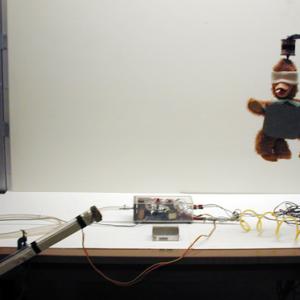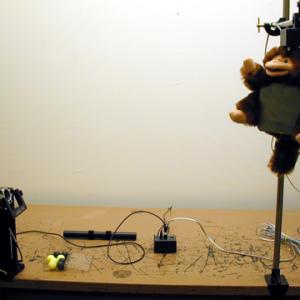College of Liberal Arts & Sciences
1D60.30 - Shoot the Monkey
The setup is pretty much self evident from the photographs, with special attention to three parts. Make sure the electronic plug from the air gun is plugged into the control box right side up. Connect the air hose to the proper end of the air gun (the end opposite the photocell). Load ammunition into the gun before pressing the reset button and positioning the monkey.
The Pasco apparatus works much the same with two minor variations. The first is that this uses a spring gun and not an air gun. The second is the make up of the magnet that hold the monkey. Instead of having a continuously energized electromagnet, this uses a permanent magnet that is momentarily canceled with a electromagnet.
- Mark Winstein, "Rolling Balls For Projectile Motion", TPT, Vol. 42, #6, Sept. 2004, p. 378.
- Paul Hewitt, "Figuring Physics: Projectile", TPT, Vol. 40, #6, Sept 2002, p. 328, 373.
- Marvin De Jong, "Interfacing Microcomputers: Back to the Future", TPT, Vol. 40, #6, Sept 2002, p. 360.
- April Fowler, "A Projectile Motion Experiment", TPT, Vol. 34, #3, Mar. 1996, p. 155.
- Dean Baird, "The Blowgun as a Teaching Tool", TPT, Vol. 34, #2, Feb. 1996, p. 98.
- Yoav Ben-Dov, "Why the Dart Always Hits", TPT, Vol. 31, #9, Dec. 1993, p. 526.
- T. M. Kalotas, A. R. Lee, and R. B. Miller, "Einstein on Safari", TPT, Vol. 29, #2, Feb. 1991, p. 122.
- Robert A. Egler, "Student Misunderstanding of the 'Monkey and the Hunter'", TPT, Vol. 27, #5, May 1989, p. 356.
- William Gombka and Joseph Steigauf, "The Falling Monkey Problem", TPT, Vol. 25, #9, Dec. 1987, p. 577.
- Mike McIntosh and Ann Brandon, "Shoot the Monkey", TPT, Vol. 25, #8, Nov. 1987, p. 532.
- R. D. Edge, "Shoot the Monkey", TPT, Vol. 20, #4, Apr. 1982, p. 260.
- Akio Saitoh, "Long Range Apparatus for Monkey and Hunter Demonstration", TPT, Vol. 19, #8, Nov. 1981, p. 563.
- Charles W. Scherr, "The Monkey and the Hunter", TPT, Vol. 17, #3, Mar. 1979, p. 184.
- Lester Hirsch, "A New 'Monkey' in the "Monkey-Hunter" Demonstration", TPT, Vol. 16, #5, May 1978, p. 327.
- Mark Winstein, "Rolling Balls for Projectile Motion", TPT, Vol. 15, #8, Nov. 1977, p. 500.
- William P. Brown, "Monkey and Hunter in Slow Motion", TPT, Vol. 15, #6, Sept. 1977, p. 368.
- Eric Rodgers, "Portable 'Monkey and Hunter' Apparatus", TPT, Vol. 13, #5, May 1975, p. 308.
- Kenneth Wright, "Capturing the Projectile in the Monkey and Gun Demonstration", TPT, Vol. 10, #5, May 1972, p. 263, also A Potpourri of Physics Teaching Ideas - Mechanics, p. 47.
- Menno Fast, "Apparatus for Teaching Physics: Blow Gun for the Hunter and Monkey Demonstration", TPT, Vol. 10, #4, Apr. 1972, p. 216.
- J. Gibson Winans, "Trajectories Without Trigonometry", TPT, Vol. 9, #6, Sept. 1971, p. 341.
- James Moore, "The Hunter and the Monkey", TPT, Vol. 9, #5, May 1971, p. 282.
- H. L. Armstrong, "Comment on Trajectories Without Trigonometry", TPT, Vol. 9, #1, Jan. 1971, p. 41.
- Ralph Vesecky, "Solving the Trajectory Problem without Trigonometry", TPT, Vol. 8, #5, May 1970, p. 263.
- A. C. Giere, "On Aiming a Rifle to Correct for Gravity", TPT, Vol. 6, #1, Jan. 1968, p. 36.
- William F. Poole, "Three Demonstrations of Projectile Motion", TPT, Vol. 5, #6, Sept. 1967, p. 272.
- Edmund C. Bray, "Experiments with Falling Bodies", TPT, Vol. 2, #7, Oct. 1964, p. 336.
- Hyman R. Cohen, "A General Solution of 'The Falling Monkey' Problem", TPT, Vol. 2, #5, May 1964, p. 227.
- J. Rosenthal, "The Hunter and the Monkey: Another View", AJP, Vol. 53, #10, Oct. 1985, p. 937.
- B. Stahlberg and E. Pesonen, "Optoelectronic Version of the 'Monkey-and-Hunter' Demonstration, AJP, Vol. 50, #5, May 1982, p. 470.
- F. D. Medina, "Looking at Projectile Motion from a Different Angle", AJP, Vol. 46, #12, Dec. 1978, p. 1282.
- Albert A. Bartlett, Gary Fladstol, and Lori Laingor, "Accuracy of the 'Monkey and the Hunter' Demonstration", AJP, Vol. 43, #6, June 1975, p. 562.
- Chris Zafiratos, Harry Clark, and Robert Stoller, "Compressed Air Launch Mechanism for the 'Monkey and the Hunter' Demonstration", AJP, Vol. 43, #6, June 1975, p. 562.
- Albert A. Bartlett, Harry Clark, and Robert Stoller, "Improvements in the 'Monkey and the Hunter' Demonstration Apparatus", AJP, Vol. 43, #6, June 1975, p. 561.
- Thomas H. Osgood, "Improved Projectile Demonstration", AJP, Vol. 36, #4, Apr. 1968, p. 367.
- Robert A. Egler, "Real Ballistics and the Monkey and the Hunter", PIRA News, Vol. 6, #1, Aug. 1991.
- Freier and Anderson, "Mb-16. Monkey and Cannon", A Demonstration Handbook for Physics.
- "M-170. Monkey Gun", DICK and RAE Physics Demo Notebook.
- Richard M. Sutton, "M-92. Falling Target", Demonstration Experiments in Physics, p. 43 - 44.
- Harry F. Meiners, "7-2.20", Physics Demonstration Experiments , p. 128 - 131.
- Harry F. Meiners, "7-2.11", Physics Demonstration Experiments, p. 125.
- Robert Ehrlich, "2.6. A 'Monkey-Hunter' Variation", Why Toast Lands Jelly-Side Down, p. 30 - 31.
- Robert Ehrlich, "A.2. Monkey and Hunter - Demonstration on an Incline", Turning the World Inside Out, p. 4 - 6.
- David Kutliroff, "39. The Hunter Shoots the Monkey", 101 Classroom Demonstrations and Experiments For Physics Teachers, p. 89 - 90.
- Julien Clinton Sprott, "1.4. The Monkey and the Coconut", Physics Demonstrations, ISBN 0-299-21580-6, p. 10 - 12.
- "A Versatile 'Cannon'", The Project Physics Course - Teachers Resource Book: Concepts in Motion, p. 112 - 113.
- Steve Hester, "Projectile Motion Demonstrator".
- Traci Maxted, "Monkey and Hunter Demonstration", Dec. 1993.
- Julius Sumner Miller, Q162 & A162, Millergrams II – Some More Enchanting Questions for Enquiring Minds, p. 37 & 94.
Disclaimer: These demonstrations are provided only for illustrative use by persons affiliated with The University of Iowa and only under the direction of a trained instructor or physicist. The University of Iowa is not responsible for demonstrations performed by those using their own equipment or who choose to use this reference material for their own purpose. The demonstrations included here are within the public domain and can be found in materials contained in libraries, bookstores, and through electronic sources. Performing all or any portion of any of these demonstrations, with or without revisions not depicted here entails inherent risks. These risks include, without limitation, bodily injury (and possibly death), including risks to health that may be temporary or permanent and that may exacerbate a pre-existing medical condition; and property loss or damage. Anyone performing any part of these demonstrations, even with revisions, knowingly and voluntarily assumes all risks associated with them.

